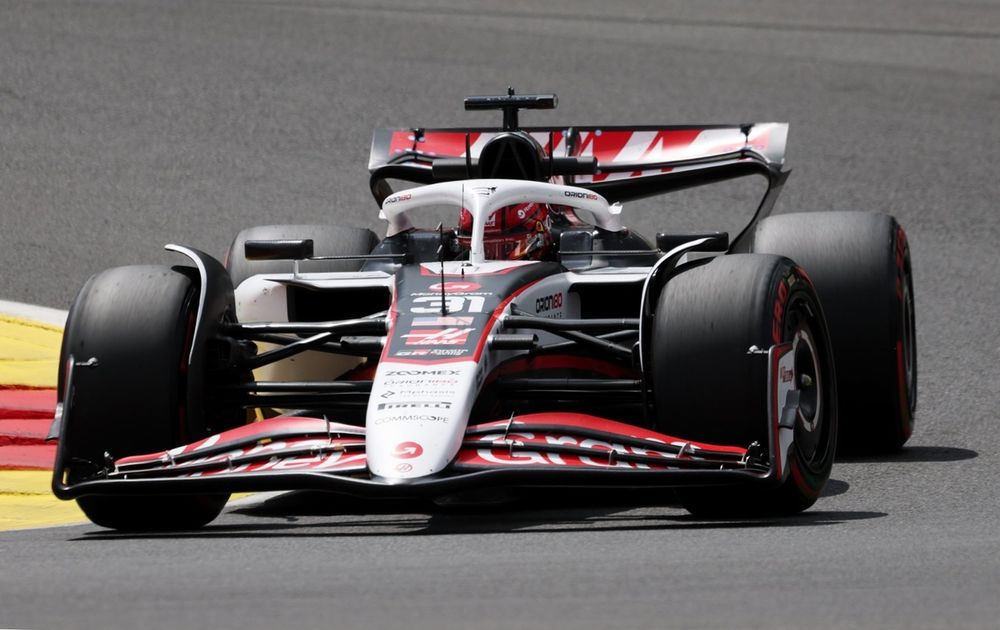Haas has brought a floor upgrade to the United States Grand Prix, aiming to improve its Formula 1 car’s balance and grip while opening up set-up opportunities.
With financial and testing resources strictly limited by the budget cap and aerodynamic testing restrictions, teams are focusing on the revamped 2026 regulations with new chassis and engine characteristics.
Haas has however been pushing longer than its rivals on improving its 2025 challenger, with eighth place in the constructors’ championship still within reach as the American team’s deficit to Sauber is just nine points.
This weekend at the Circuit of the Americas, Esteban Ocon will trial a new floor during the sole practice session before the squad makes a decision on whether to use it on both cars or none in sprint qualifying.
Asked by Autosport how much of the upgrade is performance and how much is drivability and flexibility, team principal Ayao Komatsu explained: “It’s both. You improve the overall performance and the drivability and stability; the package that gives more predictability gives the driver more confidence – that means better drivability.
“The Silverstone package direction [with a new floor then] confirmed to us how we should be developing the car, and in theory, this is another extension of the step we did in Silverstone. It was more predictable, more consistent.
Ayao Komatsu, Team Principal of Haas
Photo by: Simon Galloway / LAT Images via Getty Images
“In a way, [the new upgrade] should open up the set-up opportunities, because certain things, it was limiting us to set up the car in certain directions.”
Having scored only one point over the last five grands prix, Ocon concurred: “I hope it’s going to give us a bit more balance in places that we need.
“The last time we put the upgrade in Silverstone, that’s the direction it went, that was a positive direction and I hope this will go a step further. And of course giving us a bit more grip also, that would be nice.
“Hopefully we will find a little bit of performance and hopefully that’s going to give us a little bit more help to be scoring points more frequently. We need to be scoring, that’s for sure.”
Having just one practice session to trial the upgrade is far from ideal, especially as rookie Oliver Bearman might go straight into qualifying with a new package, but Komatsu insisted that this wouldn’t be an issue.
“I think he should be okay, because we’ve done bigger changes before,” the Japanese said. “Like the Spa sprint weekend, what we had to change on Esteban’s car between FP1 and sprint quali – essentially going from a much higher downforce setting to a lower setting. The difference [at Spa] was much bigger than the upgrade.

Esteban Ocon, Haas F1 Team
Photo by: Sam Bloxham / LAT Images via Getty Images
“So provided the characteristics we developed is correct – and essentially both our drivers, Ollie and Esteban, want the same thing, in terms of stability, in terms of through-corner balance – if we measure and if Esteban’s feedback after FP1 is positive, I don’t see any reason why it’s not positive on Ollie’s car.”
Komatsu is determined to prove that the Haas team is skilled enough to develop a car throughout an F1 season, as it has had a reputation for failing to do so, having scored just 8% of its 2022 and 2023 points tallies after July. However, in 2024 – Komatsu’s first year as team principal – Haas collected 31 points after the summer break, while the team’s current post-break tally is 11.
“Assuming that tomorrow’s [upgrade] goes well, I have to say I’m really happy how we’ve been developing the car,” Komatsu said.
“Two years in a row before we’ve been told we cannot develop the car, and then last year we proved we could – and then this year, the same people basically working together proved the second year in a row that we can develop the car, so that gives everybody a huge amount of confidence.”
We want to hear from you!
Let us know what you would like to see from us in the future.
Take our survey
– The Autosport.com Team
Read the full article here

